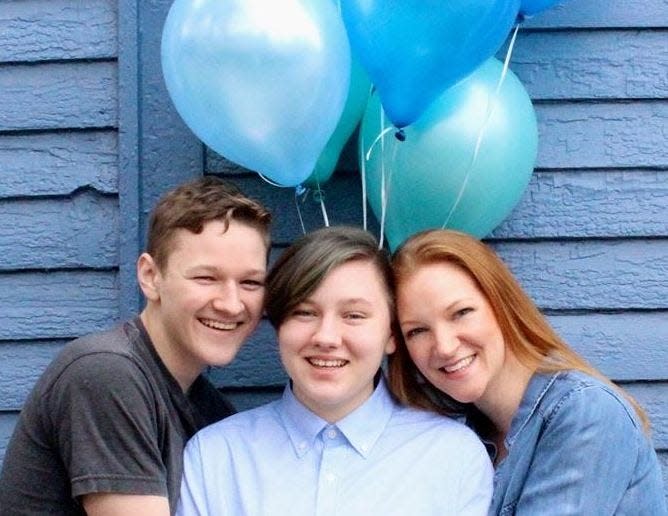Transgender and nonbinary youths are coming out at younger ages, survey says. Risks remain.
Transgender and nonbinary young people are coming out at younger ages, a national LGBTQ youth advocacy group found, with 1 in 10 having come out before age 13.
But despite greater acceptance of LGBTQ people in the U.S., coming out for younger people can mean earlier vulnerability to harassment, discrimination and violence in addition to higher risk of suicide.
“These findings speak to the impossible duality that transgender and nonbinary young people are dealing with,” said Jonah DeChants, senior researcher for the Trevor Project, a suicide prevention agency focused on LGBTQ youths. “Visibility and understanding of trans people are at an all-time high – and yet, at the same time, they are witnessing a historic wave of anti-trans political attacks that target their very existence.”
The project, based in New York, compiled the brief from data collected for its 2022 survey of nearly 34,000 LGBTQ youths nationwide. DeChants said the findings were especially meaningful given the recent international observance of Transgender Day of Visibility and called for more support of trans and nonbinary youths as legislation targeting the population proliferates around the country.
“Taking even small steps to support the trans young people in our lives can be, quite literally, life-saving,” DeChants said.
Rising visibility, acceptance help ease fears
According to the Trevor Project data, transgender and nonbinary young people age 13 to 17 reported coming out at an average age of 14, with 17% of them coming out before 13. In contrast, those 18 to 24 reported coming out at an average age of 18, with just 3% having come out before 13.
Jay Brown, senior vice president of programs, research and training for Human Rights Campaign, said differing levels of LGBTQ acceptance over the years might account for the contrast between the two age groups.
"In 2011, we didn’t even have same-sex marriage nationwide, and transgender people and their stories were rarely visible – certainly not to the extent they are today," Brown said.

Consequently, Brown suggested the 18-to-24 age group members may have felt unsafe disclosing their identities until they grew older, "when they were likely to be out of their childhood homes and beginning to live more independently."
Furthermore, he said, the younger group may have benefited from the experience and growing visibility of the older group: As more people began to come out, even at an older age, visibility and acceptance of trans and nonbinary people rose as well.
"More visibility increases familiarity and acceptance," Brown said. As those among the 13-to-17 cohort witnessed the positive coming-out experiences of older transgender and nonbinary peers, "they were more willing to come out at younger ages."
Coming out earlier raises exposure to abuse, stigma
The project also found that people coming out at younger ages faced increased risk of suicide and victimization, with those experiencing both at even higher risk.
More than 6 in 10 – 62% – who came out before age 13 said they’d seriously pondered suicide in the previous year, with 29% having attempted it. Among those who came out later, 51% had considered suicide and 17% had attempted it.

Meanwhile, 52% of transgender and nonbinary youths who came out before age 13 said they’d been physically threatened or harmed because of their gender identity, compared with 39% of those who came out later. Among youths who came out before age 13, those who experienced victimization were nearly twice as likely to attempt suicide as those who did not.
"It is not single encounters of discrimination that lead to increased risk of suicidality and poor mental health," Brown said, "but rather repeated encounters over time."
The dangers of not coming out
Youths who delayed coming out also faced risks, the project found: Those who did not come out within two years of first thinking they might be transgender or nonbinary were 45% more likely to have attempted suicide in the past year.
One factor that did make a difference was support from one's family, the data showed. Among youths who came out before age 13, those who enjoyed high family support were less likely to have seriously considered suicide (44%) or attempted it (17%) in the previous year than those who did not (67% and 30%, respectively).

"These findings support what research has consistently shown," DeChants said. "LGBTQ young people are not inherently prone to suicide risk but rather placed at higher risk because of how they are mistreated by others."
Brown agreed.
"These findings show that the answer is actually quite simple," he said, "and that is to accept, affirm and support the transgender and nonbinary people in your life."
Dig deeper:
A 'crisis': 1 in 4 Black transgender, nonbinary youths attempted suicide in previous year, study finds
Study: Gender-affirming care helps save lives, cuts depression risk in transgender and nonbinary youth
'War' on LGBTQ existence:: 8 ways the record onslaught of 650 bills targets the community
This article originally appeared on USA TODAY: Transgender, nonbinary youths come out at younger ages, but risks rise

